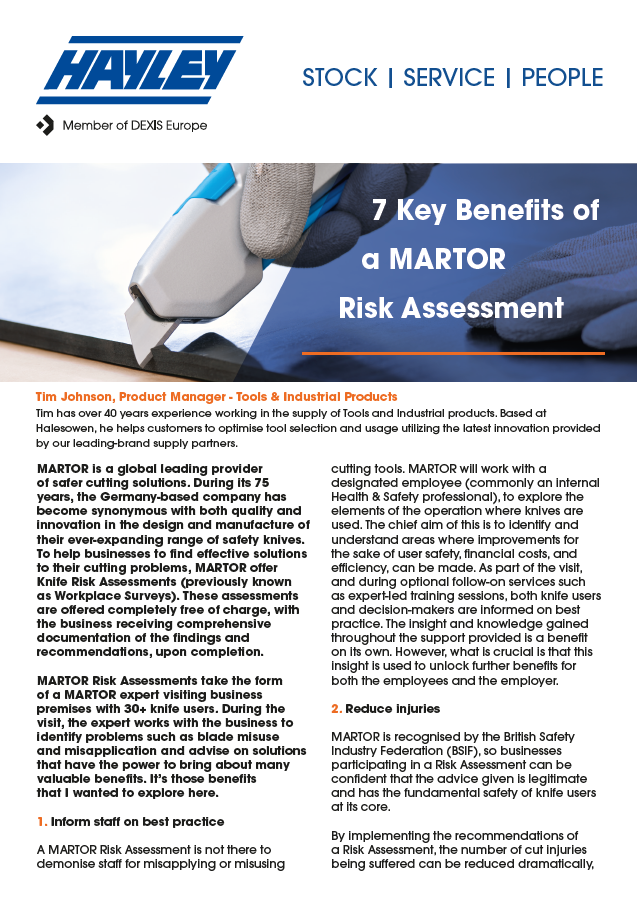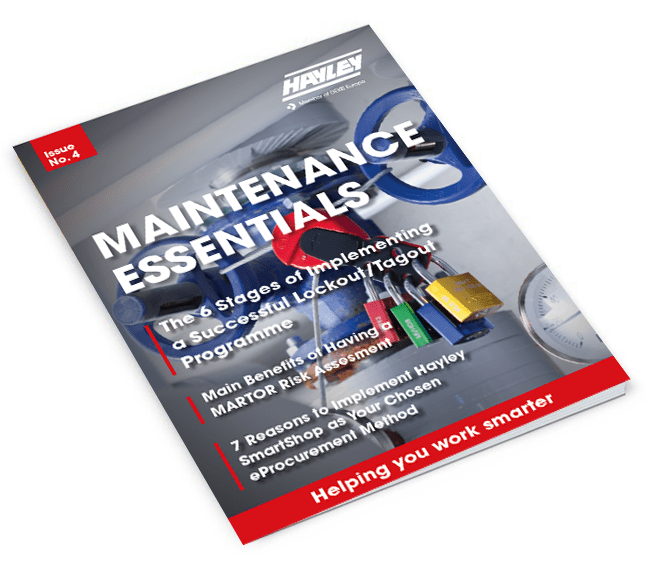MARTOR is a global leading provider of safer cutting solutions. During its 75 years, the Germany-based company has become synonymous with both quality and innovation in the design and manufacture of their ever-expanding range of safety knives. To help businesses to find effective solutions to their cutting problems, MARTOR offer Knife Risk Assessments (previously known as Workplace Surveys). These assessments are offered completely free of charge, with the business receiving comprehensive documentation of the findings and recommendations, upon completion.
MARTOR Risk Assessments take the form of a MARTOR expert visiting business premises with 30+ knife users. During the visit, the expert works with the business to identify problems such as blade misuse and misapplication and advise on solutions that have the power to bring about many valuable benefits. It’s those benefits, some of which are more conspicuous than others, that I wanted to explore here.
1. Inform staff on best practice
A MARTOR Risk Assessment is not there to demonise staff for misapplying or misusing cutting tools. MARTOR will work with a designated employee (commonly an internal Health & Safety professional), to explore the elements of the operation where knives are used. The chief aim of this is to identify and understand areas where improvements for the sake of user safety, financial costs, and efficiency, can be made. As part of the visit, and during optional follow-on services such as expert-led training sessions, both knife users and decision-makers are informed on best practice. The insight and knowledge gained throughout the support provided is a benefit on its own. However, what is crucial is that this insight is used to unlock further benefits for both the employees and the employer.
2. Reduce Injuries
MARTOR is recognised by the British Safety Industry Federation (BSIF), so businesses participating in a Risk Assessment can be confident that the advice given is legitimate and has the fundamental safety of knife users at its core.
By implementing the recommendations of a Risk Assessment, the number of cut injuries being suffered can be reduced dramatically, improving the overall safety of employees in the workplace. Take a recent example where recommendations helped a major international furniture manufacturer to reduce cut injuries by 70% in just two years. Alternatively, consider the case of a UK Naval dockyard reducing their number of blade-related injuries from one per week to less than one per month – a decrease of 80%.
3. Cut incident administration costs
While injuries will always affect the injured party more than any other, the financial and time costs associated with the administration of incidents should not be overlooked. The costs of cut injury administration are consistently found during site visits to be mostly hidden and therefore often ignored. During recent discussions with a health and safety professional at a British scaffolding business, it came to light that every injury, no matter how minor, costs the organisation £500. These costs often arise from investigation and reporting procedures, and the process of agreeing on corrective action. It’s easy to see how these costs can soon add up, especially given the rate of injuries caused by blades that some businesses report during Risk Assessments.
4. Help to ensure compliance
The Provision and Use of Work Equipment Regulations (1998) (PUWER), stipulate that equipment used in the workplace are suitable and safe for use. They also require that equipment is only used by staff who have received adequate instruction and have been provided with additional relevant products such as PPE or safety devices.
By implementing the recommendations of a MARTOR Risk Assessment, businesses can help to ensure that they are complying with PUWER. This reduces the risk of penalties being imposed, in the event of any breach.
5. Reduce product damage
Another benefit that businesses have fed back following the implementation of Risk Assessment recommendations is the reduction in damage to products. Several onsite visits have identified problems with box-opening procedures, with incorrect tool selection causing damage to products. Using blades of a length capable of penetrating not only the box being opened but also the product inside, is an accident waiting to happen. Whether it’s soft furnishings, packets of food items, or wooden furniture inside, if sliced by a knife, the item(s) could be rendered unsellable. This presents a real logistical problem with potentially significant cost implications for the business.
By using the MARTOR SECUMAX 350 the risk of damaging products when opening packaging is eliminated, as the knife has a recessed blade for enhanced safety.
6. Improve knife control
Employers are responsible for ensuring equipment meets PUWER requirements, whether the equipment has been provided by them or not. MARTOR Risk Assessments have uncovered several cases where staff have been bringing their own knives to work, to make up for the shortcomings of knives provided by their employer. In an extreme example, a knife amnesty was held which resulted in knives with tampered safety mechanisms and blades with rudimentary handles being handed-in by staff. Losing control of cutting tools in this way can have serious consequences, as employers remain responsible for them whilst they are being used on company property.
As a result of a Risk Assessment, the shortcomings of the knives being used within a business’s operation are highlighted and the problem can then be tackled appropriately by decision-makers.
7. Improve productivity
The final benefit that I wanted to cover in this piece, is that MARTOR Risk Assessments can help to boost the productivity of bladed-tool users. With the recommendations taken on-board, and the knives within the company optimised for specific usage requirements, users can complete tasks quicker and safer than before. The time savings made due to improved cutting tool performance will contribute towards efficiency improvements across the wider operation.
Hayley Group is a long-established distribution partner for MARTOR products and can source the very latest, and market leading safety cutting tools, for its customers. Through Hayley Group, customers are also able to request a MARTOR Risk Assessment to better understand areas for improvement.
Contact your local branch to arrange your FREE Risk Assessment!




